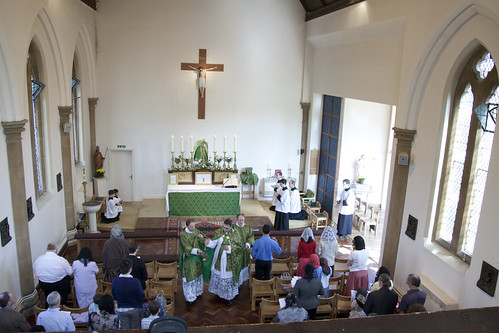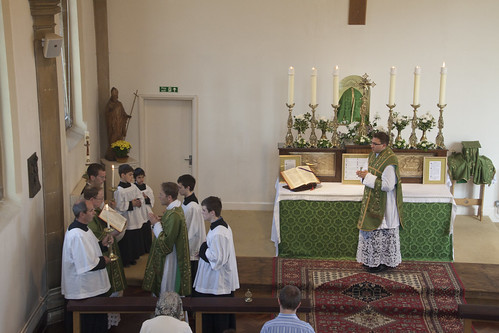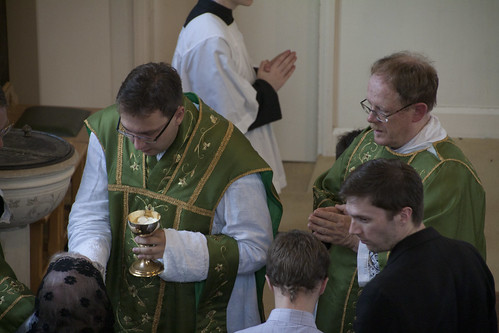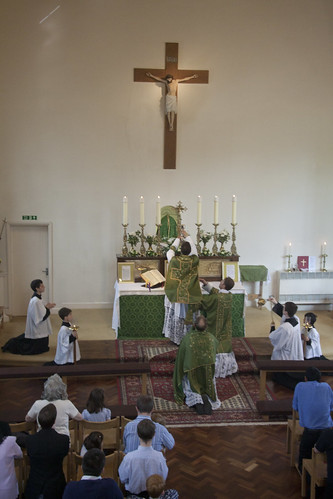
Asperges: not something you'd fail to notice.
I have just read somewhere someone being quoted as saying that if unless you are liturgical expert you'd hardly be able to tell the difference between the OF in Latin - the 1970 Missal - and the EF - the 1962 Missal. It doesn't matter where I read it or who was being quoted, because I've heard this dozens of times. And it doesn't make any more sense on the umpteenth repetition.

The Gospel: proclaimed from the North side of the Sancturary in a Solemn Mass, here, or from the North end of the Altar, at a Missa Cantata, not from a lectern or ambo.
So you go to your local parish where they always do Mass in Latin in the OF (I know, these are in single figures in the UK but bear with me) and, when the priest comes in, instead of going round the altar and saying the Introductory Antiphon (probably after waiting for a vernacular hymn to finish) he starts a chant you've never heard before and sprinkles the people with holy water. Oh and he's wearing a completely different vestment, which he then very publicly takes off in order to put his usual one on, but you still don't get the Introductory Antiphon; instead he starts a long dialogue with the servers, and when that's over he doesn't go round the altar at all, but stays on your side of it. You then notice that the altar is set up differently, with candles and crucifix at the back, and that there are no altar girls. And the music has been completely different, with the choir singing the Introit and the Kyrie without a break.

Communion distributed to the faithful kneeling and on the tongue. And spot the mantilla!
But hey, you don't notice any of this because you're not a liturgical expert. But perhaps you'd notice that the Gospel is sung in Latin - yes I know you can do that, and some of the other things I've mentioned, in the OF, but it is about as common as having the sermon in Latin, and if we are talking about what people notice we should stay with what actually happens, and not what is theoretically possible. As well as having the readings chanted in Latin, the lectern is not used. If you've still not noticed that things are different today, the canon of the Mass is said silently. Oh come off it, if you don't notice that then you're either deaf or asleep. Maybe you'll wake up in time for the Last Gospel.
I've just used the example of Sung Mass on a Sunday. It is commonly said that the EF-OF contrast is less striking with Sung Mass and this is true, mainly because of the way the congregation can join in with some of the responses, probably using the same tones. On occasions where there are more clergy present, the difference between a Solemn Mass, with deacon and subdeacon, on the one hand, and a group of priests concelebrating, on the other, is so manifest that it is hardly necessary for me to spell it out.

The consecration at a Solemn Mass.
If I were to compare Traditional Low Mass with an OF Latin Mass without music the differences would be even more evident. The Prayers at the Foot of the Altar dominate the opening sequence of events and the responses being made by the server alone give the Mass a very different feel, as does the priest celebrating ad orientem. And yes I know that in a few places the OF is celebrated ad orientem but that is neither typical nor what is recommended by 'the rules', the current edition of the General Instruction of the Roman Missal. If we are talking about a priest following 'the rules' then we must be consistent. (For a side-by-side comparison of the texts, see here.)
A random photo of a concelebrated Mass. Not something easily confused with a 1962 Missa Solemnis.

When I see a really silly claim like this, repeated by apparently sane people a great many times, I want to know what the motivation is. Why do so many people want to minimise the difference between the different forms of the Roman Rite? It may be that they think this is necessary to underpin the claim that both are valid (in all senses of the word) celebrations of the Sacrament of the Holy Eucharist, but I don't hear them claiming that only an expert would notice that he'd wandered into a Byzantine Rite church on a Sunday morning.
Then again, it may be that the argument goes like this: there are surface differences and there are deep differences. The non-expert won't notice the deep ones, and the surface ones are only surface, so they don't matter. This may indeed be at the back of the minds of the people saying the differences are hardly noticeable, especially if they have dismissed in advanced the Asperges and the Prayers at the Foot of the Altar as non-essential, not really part of the Mass. Well maybe, but that's not the same as saying that people won't notice them. Anyway, this argument fails, and for an important reason.
There are indeed many differences between the '62 and '70 Missals which are significant, but wouldn't be noticed, or not understood in full, by a non-expert, most obviously changes to the proper prayers. Going back to the unexpected TLM I was describing, the chap in the pews, if armed with a translation, might be taken aback to hear, for example, the collect of the 4th Sunday of Lent:
'Grant, we beseech Thee, O Almighty God, that we, who are justly afflicted according to our demerits, may be relieved by Thy comforting grace.'
What he won't know, unless he's read up on the issue, is that to create the 1970 Missal hundreds of collects were edited or rewritten to remove references to sin, punishment, merit, grace, and the intercession of the saints. What the newcomer to the TLM will notice, however, is other differences with a similar explanation, such as, in the EF, the use of black for Requiems, and the priest's Confiteor before the server's.
Again, someone following a translation to the EF may be slightly surprised by the reference to 'oblation' at the Offertory, and reflect that he doesn't read that word much in the translation of the Latin OF. What he won't know about, unless he's read up on it, is the consistent effort by the reformers of the liturgy to remove elements which create an ecumenical barrier, of which the notion of oblation is a prime example. What he will, nevertheless, notice, is other things which serve to emphasis distinctive Catholic doctrines, such as the Real Presence, including the priest's genuflection before picking up the Sacred Species, and communion kneeling and on the tongue.
In short, because the reform followed a consistent policy, surface differences are not a bad guide to deep differences. The things people pick up on (and sometimes complain about) when they are used to the Mass in one form and are then exposed to the other form, may not be of huge importance in themselves, but they are frequently illustrative of deep differences of real theological importance.
The biggest paradox of all with the claim that non-experts won't notice the difference is that it tends to be used by people who are actually quite sensitive to what the faithful notice when the liturgy is changed, and are concerned about it. For with the next breath the claim is often made: in order to minimise upset and complaints, if we want to improve the liturgy we should introduce the Latin Novus Ordo into our parishes, and not make the great leap to the Traditional Latin Mass.
So the argument goes like this:
1. People will hardly notice the difference between Latin OF and the EF.
2. People who will happily accept the Latin OF will be very upset about having the EF imposed on them.
3. The differences between OF and EF are of no real importance (conclusion from 1).
4. It is not worth causing a row in the parish by using the EF when you can bring in the Latin OF instead (conclusion from 2 and 3).
The trouble is, claims 1 and 2 are mutually contradictory. (3 doesn't follow from 1 either.)
So this confusion is really about the 'Reform of the Reform' debate, and the best way in practice to improve parish liturgy: something I will post about tomorrow.
Photos, apart from the concelebration, are from Solemn Mass celebrated in St William of York, Reading, by Fr Marek Grabowski FSSP. You can see more about that Mass here.
An excellent article and with some extra bits it would make a good booklet: Catholic Traditionalist Liturgy (pub. by CTS ?????) I am so pleased that you pointed out theological differences - especially the mutilated [NOT "badly translated"] Propers. I was told by a Diocesan Rep. for LMS that if all the churches celebrated the New Rite properly in Latin,like one convent of OSB Nuns, there would be no need for LMS, so your piece is very valuable and should be sent to all LMS officials.Thank you for it.
ReplyDeleteGood article. Though there is one exception I feel. The High Mass(NO) in The London Oratory. Sometimes when I go there I feel it is very close to the EF.
ReplyDeleteVery useful article indeed. At the same time, a similar side-by-side comparison of the "traditional" 1962 Holy Week and the pre-Pius XII version would also show striking differences.
ReplyDeleteGood post. (Which is not just my way of saying "I agree entirely".)
ReplyDelete(But, just to prove I read it carefully, the priest's confiteor should be before the server's.)
Yours pedantically, etc.